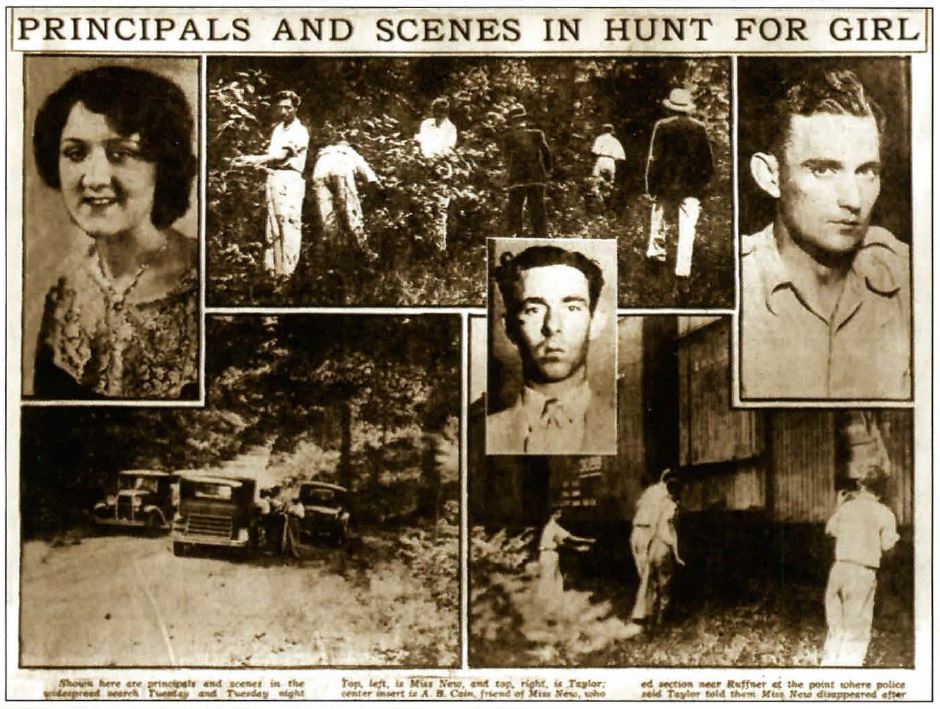What actually happened on the night of New's murder remains murky. Harold Taylor was visiting his friend, Ed Gaylord, at his gas station, the Woodlawn Oil Company, which had closed for the night. When New came in seeking help, Taylor offered to drive her and Gaylord to the car to pick up the punctured tire. After the trio took the tire to a twenty-four-hour Sinclair station, he returned Gaylord to his business. He and New returned to the car. Reaves, who was waiting there, had been joined by her brother-in-law, Ashley Cain, a young man who fancied himself to be Faye New's boyfriend. New, however, decided to go for a drive with Taylor, a handsome twenty-eight-year-old with a reputation for wild living. Cain, jealous at the perceived snub, impulsively jumped into his car and followed them as they pulled away. Later, he would maintain that he eventually lost sight of Taylor's car.
What actually happened on the night of New's murder remains murky.
Taylor himself maintained his innocence. At trial, he told the court from the witness stand, "I had been driving with my arm around Faye. Once or twice, she had reached over and kissed me." After they parked on an isolated road around midnight, he tried to "get rough" with the young girl. New pushed him away and jumped from the car. "I realized I had done the wrong thing, and started talking fast and urging her to stay in the car," he said. New ignored his efforts and ran from him. "The last time I saw her she was near the brow of the hill and seemed to be going near the top," he said.
In September 1934, the trial of the so-called "Wolf of Woodlawn" received front-page coverage in local newspapers. Articles profiled mothers and friends of both the victim and the defendant, and public sympathy was clearly divided. "Choosing at random, life could present no sadder picture," Birmingham News reporter Dolly Dalrymple wrote of the defendant and victim's mothers. Despite the attention received by the families, the principal players in the media coverage were the lawyers: flamboyant defense attorney Morel Montgomery and prominent criminal attorney Roderick Beddow, who had been retained by the New family as a special prosecutor.
In September 1934, the trial of the so-called "Wolf of Woodlawn" received front-page coverage in local newspapers. Articles profiled mothers and friends of both the victim and the defendant, and public sympathy was clearly divided.
In his closing arguments, Beddow, who called the murder a "lust killing," tried to highlight the things he knew Taylor had done wrong. In arguing that Taylor should receive the death penalty, Beddow stressed Taylor's callousness in letting the girl out "near some Negro houses," where she would be vulnerable to a race attack. Despite the testimony of Clara Cost, a woman who claimed that Taylor had also tried to attack her during an evening drive, he was found "not guilty" by the all-male jury, who spent fifteen hours in deliberation.
On September 9, the day Taylor's verdict was announced, Birmingham's citizens waited anxiously for news from the courtroom. To feed widespread interest in the case, the Birmingham Age-Herald printed nineteen thousand extra copies. The next day, the Age-Herald reported the reactions of Taylor's mother, New's parents, and Cain, all absent from the courtroom when the verdict was read. While Taylor's mother wept rears of joy, New's parents were inconsolable. Cain, who was at work, said, "Since Taylor has been acquitted now, I guess a lot of people will think me guilty, but I have told the truth from the beginning."
Soon after Taylor's acquittal, a former law enforcement official turned in a knife that he believed was the weapon in New's murder. Investigators offered little optimism that the instrument was of any value, but they vowed to follow up on all new leads. Faye New's murder, which had captivated Birmingham for two months, faded from the pages of the newspapers and the minds of the public. The identity of her killer, whether it was Taylor, Cain, or some other unnamed face, was never determined.
This feature was previously published in Issue 86, Fall 20017.
Author
Pamela Jones is a freelance writer and researcher based in Birmingham. her particular areas of interest in Alabama history are true crime and the state between the two world wars. She is a history instructor at a Birmingham college and writes corporate histories.

 RSS Feed
RSS Feed